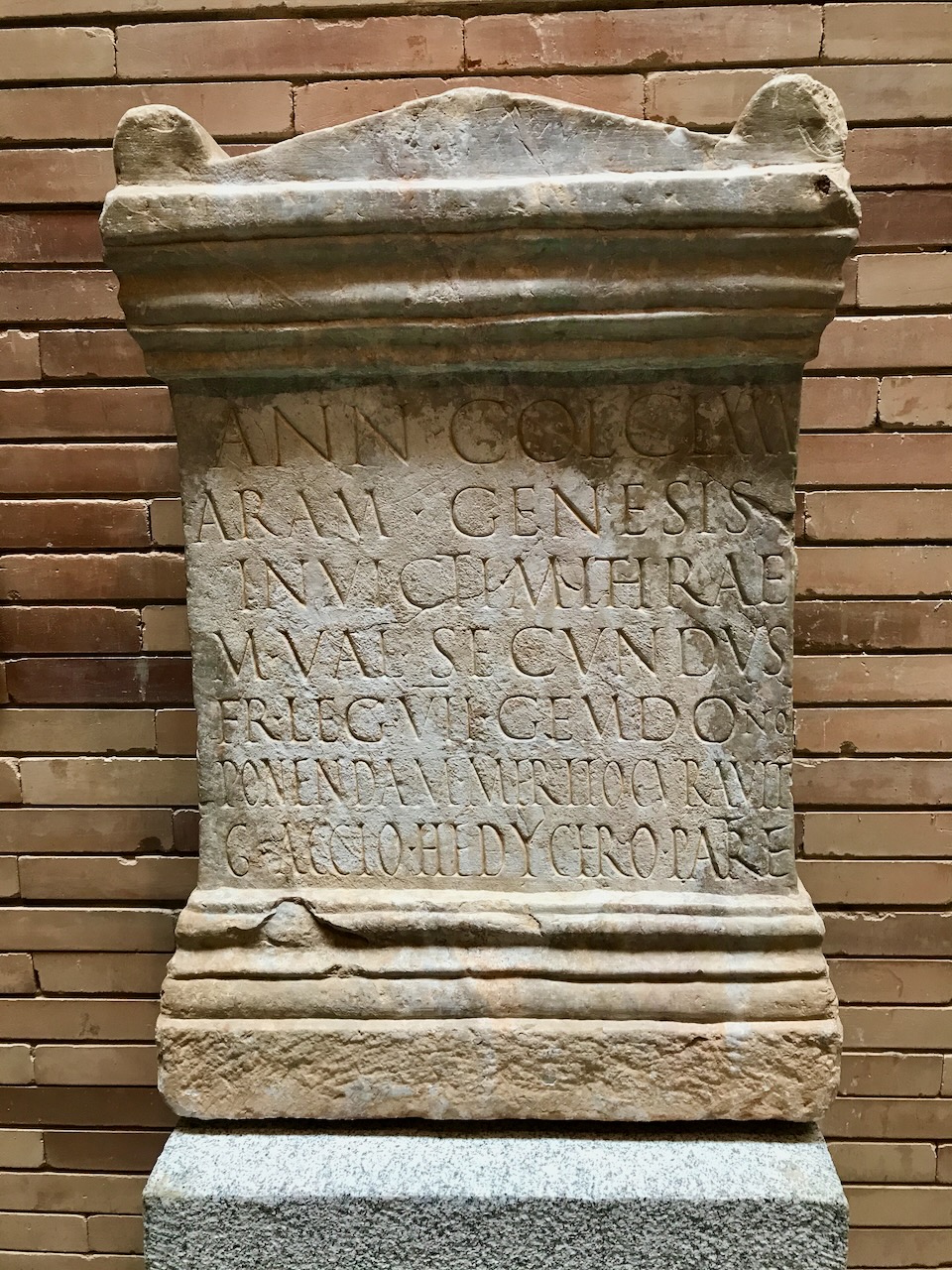
Marcus Valerius Secundus
Centurio frumentarius probably from Tarraco, who served in the Legio VII Gemina located in Emerita Agusta.
Biography
of Marcus Valerius Secundus
- Marcus Valerius Secundus was a syndexios (probably a Pater).
- Active c. 155 in Emerita Augusta, Lusitania.
- He served in the Legio VII Gemina.
TNMP 8
Marcus Valerius Secundus is a centurion frumentarius, thus belonging to the officium of the provincial governor; his origin seems to be in Tarraco where his epitaph was found paid for by his freedmen.
During the reign of Antoninus Pius (138-161 AD), in the year 155, if we follow the traditional chronology of the foundation of Emerita Augusta, there was at least temporarily in the capital of Lusitania an interesting character, Marcus Valerius Secundus, who presumably maintained a close relationship with an ancient freedman of presumed oriental origin, Gaius Accius Hedychrus.
This Marcus Valerius Secundus was most likely a frumentary centurion of the Legio VII Gemina, encamped in what was to become the future city of Leon.
The frumentiaries belonged to the legions in which they served with the mission of guaranteeing their logistics, maintaining links with other provincial garrisons and procuring information for the central government following their enquiries during their tours, during which they depended on the provincial governors.
When they went to Rome, the Frumentiaries were housed in the Castra Peregrinorum, the headquarters of these provincial troops located in Celio.
[...] Regardless of the specific circumstances of his adherence to the cult, Marcus Valerius Secundus was not acting alone. His choice, his religious options, did not derive from an act of his personal will, but from the web of his networks, which begin with the process of socialisation in childhood and culminate in the fabric of personal relationships in adulthood.
[...] These circumstances make it highly probable that Valerius Secundus came to Mithraism as a military man, not from a revelation or knowledge that led to some sort of conversion.
We do not know where he came into contact with the other important figure in this little story, Gaius Accius Hedychrus. He was a freedman whose Eastern Greek cognomen seems to indicate that his origins were in the eastern part of the Empire. What is important in our case is that we find both characters working in unison for the consolidation of Mithraism in Emerita.
Possibly the initiative was a joint one, combining the interest of Marcus Valerius Secundus, derived from his condition as a frumentary dependent on the governor of Tarraconensis, and that of Caius Accius Hedychrus, a priest of the cult. We must suppose that in this relationship, the frumentary contributed with the support of the political and administrative authorities, as I will insist on later, and the priest with the knowledge of the religious requirements to promote the cult in the provincial capital of Lusitania.
Everything seems to indicate that the presence of M. Valerius Secundus was temporary, since what seems to be his funerary epigraph has been preserved in Tarragona, indicating that he came from Tarraco and that he belonged to the Galeria tribe; his freedmen were in charge of erecting the epitaph in the capital of Tarraco, where he probably worked in the service of the provincial governor, on whom the frumentiaries depended. From Tarraco itself, as we shall see below, come other interesting materials that could link imperial representatives with the establishment of Mithraism in Hispania.
We do not know what the exact link was between Valerius Secundus and Accius Hedychrus, promoters of Mithraism in Merida. The testimonies show how they acted in a coordinated manner, with Hedychrus assuming priestly functions.
[...] The altar [...] paid for by Marcus Valerius Secundus when Caius Accius Hedychrus was acting as pater, seems to celebrate the inauguration of the great Mithraeum of Emerita on the one hundred and eightieth anniversary of the foundation of the colony, i.e. in the year 155.
By that time, Caius Accius Hedychrus and Marcus Valerius Secundus had amassed an enormous fortune to build the great mithraeum, capable of competing with the most lavish in the Empire at the time, and to decorate it with excellent cult statues.
For this purpose they enlisted the services of a Greek sculptor, Demetrios, perhaps one of those itinerant artists hired according to the needs of each place, who would place his workshop at the service of the patrons of the Emeritan mithraeum.
Demetrios himself bears witness to this by leaving his name in Greek on one of the most accomplished pieces, the Dadaphoros. Under his direction some of the finest works were sculpted, following the models of his probable place of origin, Aphrodisias, in Asia Minor.
[...] Undoubtedly, our protagonists had to mobilise important members of the local oligarchy, won over to the cause by the institutional connections of the centurion frumentarius.
It is noteworthy that practically all the materials are archaeologically dated to the middle of the 2nd century, coinciding with the evergenetic action of Marcus Valerius Secundus and Gaius Actius Hedychro, giving the impression that there was meticulous planning in the foundation of the mithraeum in the capital and in the commissioning of its decorative elements.
From all this it can be deduced that in the middle years of the 2nd century, there was proselytising work in Mérida, thanks to which a Mithraic corporation was organised around two central figures, the centurion frumentarius of Legio VII, Marcus Valerius Secundus and the freedman of oriental origin, Gaius Accius Hedychrus. We do not know from where they obtained the important economic resources used in the erection of the mithraeum and its ostentatious decoration for the development of the devotion of an undoubtedly important community of the faithful.
—Jaime Alvar (2020) Mitra en Hispania
O dedicante, Marcus Valerius Secundus, é um frumentarius, ou seja, um fornecedor de mantimentos da Legião VII Gemina, facto que se quadra bem com a reconhecida popularidade do deus entre a classe militar et afins; o voto foi cumprido através da participação de um sacerdote iniciado nos mistérios mitraicos, com o grau de pater, 'pai', de nome Gaius Accius Hedychrus; tudo se assou, como expressamente vem referido no início da epígrafe, no ano CLXXX da fundação da colónia (de Emerita), o que nos remete de forma explícita para 155 d.C.
—José Cardim (2002) Ara consagrada a Invictus Mithras, por Marcus Valerius Secundus
References
- Epigraphic Database Heidelberg. Altar of Merida consecrated by Marcus Valerius Secundus in EDH
- Epigraphik-Datenbank Clauss / Slaby. Altar of Merida consecrated by Marcus Valerius Secundus in EDCS
- Hispania Epigraphica. Altar of Merida consecrated by Marcus Valerius Secundusin HE
- Mitra en Hispania. Altar of Merida consecrated by Marcus Valerius Secundus in MEH
Mentions
Altar of Merida consecrated by Marcus Valerius Secundus
TNMM 338
This altar is dedicated to the birth of Mithras by a frumentarius of the Legio VII Geminae.


Comments
Add a comment